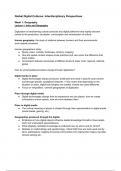Global Digital Cultures: Interdisciplinary Perspectives
Week 1: Geography
Lecture 1: Intro and Geography
Digitization is transforming cultural practices and digital platforms have rapidly become
central to the production, circulation, consumption and monetization of culture.
Human geography: the study of relations between humans and their environments:
socio-spatial processes
Human geographers study:
● Space, place, mobility, landscape, territory, mapping
● How the spatial context shapes social practices and vice versa: the difference that
place makes
● Connections between processes at different levels of scale: local, regional, national,
global
How do social-spatial processes change through digitization?
Digital media in place
● Digital technologies always produced, distributed and used in specific local context
and through specific, spatialized networks -> this means that depending on the
situation or place, digital technologies are created, shared and used differently
● Focus on inequalities: “uneven”geographies of digitization
Place through digital media
● Digital technologies change how we experience and use places, how we create
connections across spaces, how we move between them
Place in digital media
● The cultural meaning of places is shaped through their representation in digital media
(social media, gaming, etc.)
Geographies produced through the digital:
● Emphasis on how digital objects influence spatial knowledge formation (how people
learn and understand spaces/places)
● What (digitally mediated) knowledge is produced how, by whom and for whom?
● Debates on methodology and epistemology: critical GIS (how are tools used and by
who), participatory mapping (involving communities into making their maps), big data,
remote sensing etc.
,Geographies produced by the digital:
● Emphasis on how digital objects influence socio-spatial relations (connection
between people and spaces)
● Space-time compression (the world feels smaller and more connected): new
economic geographies
● “Smart cities”: digitally mediated urban governance and planning
● Code/space: space produced through code/software/apps
● Everyday spatial media creating new (hybrid, augmented) spatial practices, for
example mobilities, encounters and uses of public space
Geographies of the digital:
● Emphasis on how socio-spatial relations influence digital objects
● “Cyberspace”: problematic binaries obscuring entanglement of digital, virtual, cloud
with material, actual, analogue -> people often think of the digital and physical world
being two beings, but they’re tangled together: for example cloud is a real space
● Growing focus on material infrastructures and architectures and their socio-political
geographies (for example sensors, data centers, cables, 5G)
● From where and about what places are data produced?
● Where are digital technologies produced, how do they circulate, how do they gain
new uses and meanings in new locations?
Geographies produced through digital dating apps:
● Formation of spatial knowledge on sexuality
● Queer mapping: exploring and representing spaces from queer perspective
Geographies produced by digital dating apps:
● Dating/hookup apps enable specific connections across spatial boundaries
● Dating/hookup apps enable specific connections in space:
-Matches filtered by geolocation
-Spatial preferences (public/private) may differ per app
-Encounters can potentially become less place-based, for example disappearance of
gay bars
-These apps are used in hybrid ways at the digital/urban interface
Geographies of digital dating apps:
● Diverse digital cultures of app-mediated dating: variety across geographical and
cultural contexts
● Connection to specific cultural and political contexts: uses of apps proscribed by
cultural and legal norms, for examples authoritarian framing of queer life
● Connections to inequalities: How can dating apps facilitate
non-normative/counter-hegemonic forms of sexuality and romance?
Article 1: Digital turn, digital geographies? - Ash et al. (2018)
Digital devices and software packages have become indispensable to geographic practice
and scholarship across sub-disciplines. These digital technologies are heavily mediating
everyday tasks such as work, travel, consumption, production and leisure.
, They are now also having effects on things that concern geographers:
● Nature of economy and economic relations
● Management and governance of places
● Production of space, spatiality and mobilities
● Processes, practices and forms of mapping
● Contours of spatial knowledge and imaginaries
● Formation and enactment of spatial knowledge politics
The digital shapes how we understand and experience space and spatiality
3 categories of the relationship between geography and the digital:
● Geographies produced through the digital
● Geographies produced by the digital
● Geographies of the digital
Within these categories, overlapping is possible
Geographies through the digital
The digital has been important as a site/mode/object for knowledge production in human
geography: the digital has had a big impact on producing geographic knowledge and
enacting knowledge politics.
It brings up the question of whose knowledge is being produced and by/for whom.
Geographic information systems (GIS) like Google Earth, or earlier cartography, is a good
example for this: we always saw GIS as objective, but GIS can depict a different picture at
times, for example Google Earth showing empty shopping carts can depict homelessness.
Not only GIS serve as objects, sites and modes of knowledge production; new spatial media
are very present and connected to spatial knowledge.
Geographies by the digital
The digital is mediating and augmenting the production of space and transforming
socio-spatial relations.
Cities were starting to become more reliant on digital systems with respect to their planning,
management and governance; digital infrastructures and devices were starting to be
routinely embedded into the spatial fabric of cities.
Throughout the years:
● 1970s: Experimenting with computer models and management systems to inform
policy and govern cities
● 1980s onwards: GIS and other software became tools for urban management.
● 1990s onwards: Cities became increasingly computational with traditional
infrastructures augmented with networked sensors, transponders and actuators
Digital social inequalities have intensified alongside access to ICTs (Information and
Communication technologies)




